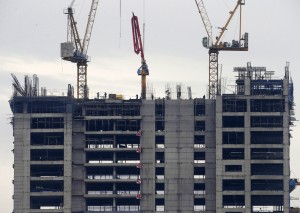Developers get selective in doing housing projects
MANILA, Philippines–Philippine property developers are turning more selective in rolling out residential projects to allow the market to absorb the large influx of inventory from aggressive launches since 2011, property consulting firm Colliers Philippines said.
In its latest quarterly report, Colliers noted that the number of applications for residential licenses filed with the Housing and Land Use Regulatory Board (HLURB) from January to August this year had grown by only 0.3 percent year on year.
The residential license applications at the HLURB, seen as a gauge of the level of property developments, showed that out of the four segments, only mid-income housing improved substantially.
Applications for mid-income housing licenses rose by 13.7 percent year on year in the first eight months while those for high-rise residential increased by only 4.4 percent.
License applications for socialized housing fell by 4.8 percent while those for low-cost housing dropped by 7.2 percent.
Overall, total licenses to sell issued by the HLURB rose by 47.9 percent but this was mostly for non-residential projects. For instance, Colliers reported a 200- percent increase in memorial park applications, noting a resurgence after a year of stagnant growth. It also cited a strong industrial sector leading to an 87-percent increase in industrial subdivisions.
Recently, a number of big property developers launched big industrial estate projects, reporting a much-improved demand from manufacturing locators.
The latest Colliers report said that the supply influx since 2011 was causing a shift in strategy among property developers in five major areas—Makati, BGC, Ortigas, Alabang and Eastwood.
“From 2015 to 2017, an average of 9,000 units will be turned over in the five major locations that Colliers monitors. After numerous project launches since 2011, developers have switched to a more conservative stance in introducing new projects in these locations,” the research said.
“Apart from decreasing availability of land options, the influx of supply expected in the next few years induced a more selective atmosphere for developers when timing becomes more important to avoid saturation in the market,” it said.
Delays in construction reduced the number of units expected to be delivered this year by 28.4 percent, from 7,746 to 5,546 units, Colliers said.
In the meantime, Colliers noted a stable growth in residential rents although residential capital value growth in premium locations was accelerating at a faster pace than rent due to rising land values.
Overall residential vacancy in the Makati CBD declined by 250 basis points, reaching 8.1 percent in the third quarter which Colliers attributed to strong take-up in Grade A and Grade B projects, with occupancy increasing by 2.7 percent in this quarter alone. Premium residential vacancy also fell, posting a vacancy rate of 4.5 percent.
“Due to vibrant leasing activities in the (Makati CBD) area, the number of units available for sale drastically decreased during the period, signifying that owners decided to hold onto their units and made them available in the leasing market to realize yield potentials,” the research said.
But Colliers believes the decline is temporary, as it forecasts a 2.6-percent jump in overall vacancy, from 8.1 to 10.7 percent.
The Colliers report also noted the following trends in rental growth in the third quarter:
— Residential rents in the Makati CBD saw quarterly growth of 1.1 percent, averaging P829/sqm per month
— In Rockwell, residential rents ranged between P745 and P1,040/sqm per month, increasing by 1 percent quarter-on-quarter
— Fort Bonifacio posted the highest rental growth at 1.2 percent quarter-on-quarter, resulting in an average rent of P834/sqm per month
Colliers predicts rental growth in Makati, Rockwell and Fort Bonifacio to hit 4 to 6 percent by next year, with Fort Bonifacio rents seen edging the Makati CBD rents by a few pesos.

